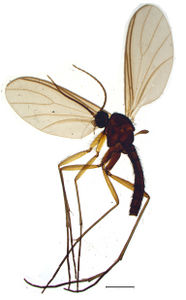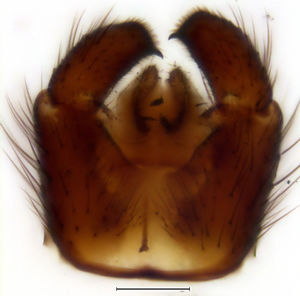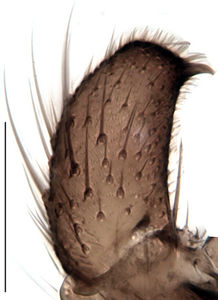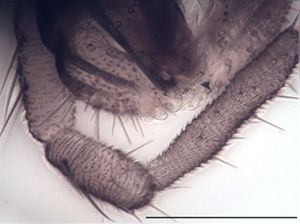Trichosiopsis cavernarum
Ordo: Diptera
Familia: Sciaridae
Genus: Trichosiopsis
Name
Trichosiopsis cavernarum unpublished
Type material
Holotype: ♂, 30.07.2012, hand collecting, leg. Weber, ZFMK-TIS-14851 in ZFMK
Type locality
Luxembourg, Machtum, Dolomitgrouf Kelsbaach
Barcoded material
| Stadium | Country | Province | Locality | Habitat | Method | Date | Collector | Collection Number | Collection | Latitude | Longitude | Elevation (m) |
|---|---|---|---|---|---|---|---|---|---|---|---|---|
| 1 ♂ (holotype) | Luxembourg | Machtum, Dolomitgrouf Kelsbaach | cave | hand collecting | 30.07.2012 | Dieter Weber | ZFMK-TIS-14851 | ZFMK | 49.6111111 | 6.40527778 | 140 | |
| 1 ♀ | Luxembourg | Schifflingen, Minière Lallengebierg | cave | hand collecting | 17.07.2013 | Dieter Weber | ZFMK-TIS-2510408 | ZFMK | 49.5061111 | 6.01194444 | 295 | |
| 1 ♀ | Luxembourg | Luxemburg, Fort Rubenpret | cave | hand collecting | 10.05.2013 | Dieter Weber | ZFMK-TIS-2501885 | ZFMK | 49.6113889 | 6.13083333 | 310 | |
| 1 ♀ | Luxembourg | Consdorf, Dewenpetz | cave | hand collecting | 12.05.2013 | Dieter Weber | ZFMK-TIS-2502048 | ZFMK | 49.7786111 | 6.33722222 | 295 | |
| 1 ♀ | Germany | Saarland | Nohfelden, Türkismühle, Adolf-Hitler-Stollen | cave | hand collecting | 12.01.2013 | Dieter Weber | ZFMK-TIS-2520538 | ZFMK | 49.5788889 | 7.11111111 | 365 |
| 1 ♀ | Germany | Saarland | Nohfelden, Türkismühle, Hermann-Göring-Stollen | cave | hand collecting | 12.01.2013 | Dieter Weber | ZFMK-TIS-2520523 | ZFMK | 49.5788889 | 7.11111111 | 365 |
| 1 ♂ | Germany | Saxonia | Dresden, Klotzsche, Dresdner Heide | wet meadow between small ponds | Malaise trap | 20.5.–28.5.2015 | André Reimann | ZFMK-TIS-2559612 | ZFMK | 51.132 | 13.819 | |
| 1 ♂ | Canada | Newfoundland and Labrador | Gros Morne National Park, James Callaghan Trail (aka Gros Morne Trail) | forest | Malaise trap | 11.6.–18.6.2013 | R.Reid | BIOUG09702-E07 | BIOUG | 49.5686 | -57.8302 | 39 |
| 1 ♂ | Norway | Buskerud | Ringerike, Veksalbekken | ravine | netting | 03.06.2014 | Kjell-Magne Olsen & Øivind Gammelmo | bf-sci-00381 | NHMO | 60.175 | 10.2 | 110 |
| 1 ♂ | Norway | Sogn og Fjordane | Laerdal, Eisurda | graaor-heggeskog | netting | 04.07.2014 | Kjell-Magne Olsen & Øivind Gammelmo | bf-sci-00402 | NHMO | 61.068 | 7.82 | 447 |
| 1 ♂ | Germany | Bavaria | Munich, E.ON Buchenhain, Isarufer | beech forest | Malaise trap | 20.4.–28.4.2011 | N. Reiff | DIP03852 | ZSMC | 48.0277778 | 11.5019444 | 550 |
| 1 ♂ | Norway | Troms | Balsfjord, Stordalselva, E RV87 | along stream | Malaise trap | 24.9.–8.10.2014 | Jostein Kjærandsen | TSZD-JKJ-104121 | TSZD | 69.182 | 19.799 | 295 |
| 1 ♂ | Norway | Troms | Malselv, Rostadalen, Innset | along stream | Malaise trap | 13.6.–12.7.2009 | T. E. Barstad | TSZD-JKJ-103968 | TSZD | 68.962 | 19.753 | 365 |
| 1 ♂ | Norway | Troms | Malselv, Rostadalen, Innset | along stream | Malaise trap | 13.6.–12.7.2009 | T. E. Barstad | TSZD-JKJ-103966 | TSZD | 68.962 | 19.753 | 365 |
Other material studied
Germany: 4 ♂, Rhineland-Palatinate, Glashütte/Lemberg, Winterbergstollen, pitfall trap, Weber, 03.05.2003, PKHH 5486; 3 ♂, Kastellaun, pitfall trap, Weber, 11.06.1995, SDEI 3399-3401; 2 ♂, Lütz, Lützbachtal, Weber, 23.05.1988, SDEI 3397/3398; 1 ♀, Rohrbach, Kascheck 2, pitfall trap, Weber, 16.05.1998, SDEI 3414; 12 ♂, Wendelsheim, Grube Bändel, manual sampling, Weber, 14.03.1993, SDEI 3403-3413; 1 ♂, Wilgartswiesen, Otterfelsenstollen, pitfall trap, Weber, 01.05.1989, SDEI 3402; 4 ♂, Saxony-Anhalt, Uftrungen, Heimkehle, Thyrastollen, pitfall trap, Eckert, 17.05.1989, PWMP 1631/1632; 2 ♂ 2 ♀, 6.6.-04.10.1989, PWMP 4036/4039 [all previous SDEI and PWMP material as Leptosciarella rejecta in Mohrig & Menzel (1997 [1]: 62)]; Italy: 2 ♂, South Tyrol, Stilfzer Joch NP, Suldental bei Schmelz, submontaner Kiefern-Mischwald, Malaise trap, Lange & Ziegler, 31.5.-11.06.2006, SDEI 2634/1638; Luxembourg: 1 ♂ 3 ♀, Dudelange, Laangebierg Italien, Weber, 23.5.-19.08.1990, PKHH 7655; 1 ♂ 1 ♀, Huldange, Kammer beim Bahntunnel Huldange, Weber, 19.05.2007, PKHH 5683; 1 ♂, Rumelange, Minière Reschelerkopp, manual sampling, Weber, 18.06.2014, PKHH 8792 [all Luxembourg material as Leptosciarella defecta in Heller & Weber (2013 [2]: 330)]; Sweden: 4 ♂, Östergötland, Omberg, Storpissan: old Norway spruce wood, Malaise trap, Swedish Malaise Trap, 28.5.-05.07.2005, NHRS 2030/2038/2040/2093; 12 ♂, Småland, Bäckebo, Grytsjöns naturreservat, Old moisty haymaking meadow in forest edge, Malaise trap, Swedish Malaise Trap Project, 4.-19.06.2005, PKHH 7441/7503/7506; 9 ♂; 23 ♂, Grytsjöns naturreservat, Old aspen forest in boulder terrain, Malaise trap, Swedish Malaise Trap Project, 18.5.-15.06.2006, PKHH 6773/6780/6801, NHRS 2912/2923; 5 ♂, Grytsjöns naturreservat, Old moisty haymaking meadow in forest edge, Malaise trap, Swedish Malaise Trap, PKHH 6830/6855; 2 ♂, Upland, Älvkarleby, Batfors, pine forest with blueberry, Malaise trap, Swedish Malaise Trap Project, 27.6.-01.07.2004, PKHH 7466.
Description (male)
Head. Eye bridge 4–5 rows of facets. Antenna unicolour. LW-index of 4th flagellomere 2.2–2.6; neck 0.15–0.35 × segment width; transition of basal part to neck pronounced. Colour of neck unicolour. Antennal setae shorter than segment width; of normal strength; sparse; adjacent. Palpus darkened, or dark; long; palpomeres 3. First palpomere elongate; with 5–7 setae; with only sparse sensilla. Second palpomere elongate. Third palpomere longer than first. Thorax. Colour brown. Notum unicolour. Thoracic setae long and strong; black. Posterior pronotum setose. Postpronotal setae 2–5; strong. Mesothoracic sclerites bare. Legs. Colour yellow-brown. Hind coxa darkened. Setae on front coxa black. Front tibial organ as patch of setae; dark; front tibial organ not bordered. Tibial setae on hind legs weak and inconspicuous. Tibial spurs of equal length. Claws untoothed. Wing. Wing slightly darkened; of normal shape. Wing membrane without macrotrichia. Wing venation weak, with faint stM. M-fork of normal shape. R1 ending at or slightly before base of m-fork; posterior veins with macrotrichia; stM mostly with macrotrichia; CuA1 and CuA2 mostly with macrotrichia; bM bare; r-m with few setae; bM:r-M 0.8–1; st-Cu:bM 0.55–0.8; R1:R 1.5–1.9; c:w 0.75–0.85. Halter darkened; of normal length. Abdomen. Abdominal setae strong; on tergites black; on sternites black. Hypopygium concolour with abdomen; LW-index 0.6–0.8. Base of gonocoxites with strong setae; gonocoxites broadly separated; inner margin of gonocoxites typically U-shaped; inner membrane of hypopygium scarcely setose; ventral margin of gonocoxite with short setae. Gonostylus elongate; LW-index 2–2.4; Inner margin straight; apex with one obtuse angle. Apical tooth present; without internal structure; strong; LW-Index 2.1–2.6. Awl-like setae normal; present beneath apical tooth. Megasetae absent. Whiplash-hair absent. Tegmen 0.3–0.5 × longer than broad; rectangular with rounded edges; without special features; central process absent. Length of ejaculatory apodeme/hypopygium 25–35 %; base of ejaculatory apodeme absent. Field with aedeagal teeth inconspicuous. Measurements. Body size 3.2–3.7 mm. Hind tibia 1.85–2 mm. Wing length 2.9–3.5 mm
Diagnosis
The species is placed in the Trichosiopsis rejecta group and can be distinguished from other, similar species by the combination of the following characters: strong setae at the base of the gonocoxites, strong and black setae at the fore coxae, gonostylus thick and with a distinctive apico-dorsal angle, palpi long and dark, posterior pronotum with several setae, tibiae with only short spines. Tr. cavernarum is similar to Tr. rejecta. Both species share the shape of the gonostylus with a distinctive apico-dorsal angle and strong setae at the base of the gonocoxites. However Tr. rejecta can be distinguished by having bright instead of black setae at the fore coxae. For the differentiation of other similar species such as Trichosiopsis defecta, Trichosiopsis phoenix, Trichosiopsis andreae and Trichosiopsis suecica see under the those species.
DNA Barcoding
The COI sequence is assigned to BIN BOLD:ACJ9928 (average distance 0.13%, max. 0.48%, n=16, K2P: 9.76%).
Ecology
Tr. cavernarum is regularly found in caves and apparently the most common troglophilic species of the genus. However, it is not limited to subterranean habitats, as there are also a lot of findings from open land.
Etymology
lat. caverna = cave. The name was chosen after the preferred habitat.
Discussion
Tr cavernarum is a semi-cryptic species, which was previously included in Tr. rejecta[1]. Because of different DNA barcodes this species was already separated earlier from Tr. rejecta and treated as Tr. defecta[2]. But even that association as presented on Species-ID was incorrect. The specimens included were still a collective assemblage as was shown by further DNA barcoding.
It is possible, that this species is identical with Trichosiopsis echinata, which is currently regarded as a nomen dubium.
Distribution
Canada, Germany, Luxembourg, Norway, Sweden.
Images
|
References
- ↑ 1.0 1.1 Mohrig, W.; Menzel, F. 1997: Revision der paläarktischen Arten von Trichosia Winnertz sensu Tuomikoski, 1960 (Diptera, Sciaridae). – Teil II. Gattungen Leptosciarella Tuomikoski, 1960 und Trichodapus gen. nov. Studia dipterologica, 4(1), 41–98.
- ↑ 2.0 2.1 Heller, K.; Weber, D. 2013: Trauermücken (Diptera, Sciaridae) aus Höhlen des Großherzogtums Luxemburg. Ferrantia, 39, 320–336.




